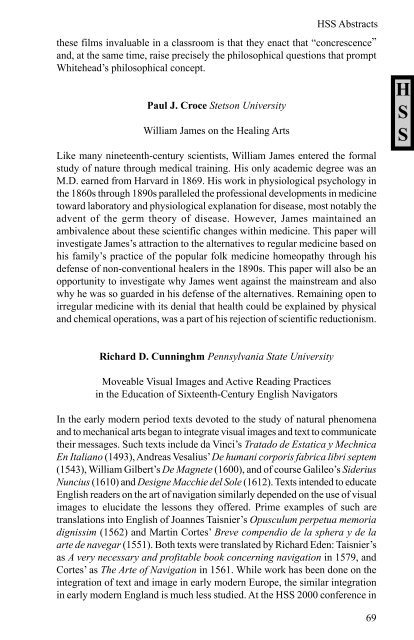2000 HSS/PSA Program 1 - History of Science Society
2000 HSS/PSA Program 1 - History of Science Society
2000 HSS/PSA Program 1 - History of Science Society
Create successful ePaper yourself
Turn your PDF publications into a flip-book with our unique Google optimized e-Paper software.
these films invaluable in a classroom is that they enact that “concrescence”<br />
and, at the same time, raise precisely the philosophical questions that prompt<br />
Whitehead’s philosophical concept.<br />
Paul␣ J. Croce Stetson University<br />
William James on the Healing Arts<br />
<strong>HSS</strong> Abstracts<br />
Like many nineteenth-century scientists, William James entered the formal<br />
study <strong>of</strong> nature through medical training. His only academic degree was an<br />
M.D. earned from Harvard in 1869. His work in physiological psychology in<br />
the 1860s through 1890s paralleled the pr<strong>of</strong>essional developments in medicine<br />
toward laboratory and physiological explanation for disease, most notably the<br />
advent <strong>of</strong> the germ theory <strong>of</strong> disease. However, James maintained an<br />
ambivalence about these scientific changes within medicine. This paper will<br />
investigate James’s attraction to the alternatives to regular medicine based on<br />
his family’s practice <strong>of</strong> the popular folk medicine homeopathy through his<br />
defense <strong>of</strong> non-conventional healers in the 1890s. This paper will also be an<br />
opportunity to investigate why James went against the mainstream and also<br />
why he was so guarded in his defense <strong>of</strong> the alternatives. Remaining open to<br />
irregular medicine with its denial that health could be explained by physical<br />
and chemical operations, was a part <strong>of</strong> his rejection <strong>of</strong> scientific reductionism.<br />
H<br />
S<br />
S<br />
Richard␣ D. Cunninghm Pennsylvania State University<br />
Moveable Visual Images and Active Reading Practices<br />
in the Education <strong>of</strong> Sixteenth-Century English Navigators<br />
In the early modern period texts devoted to the study <strong>of</strong> natural phenomena<br />
and to mechanical arts began to integrate visual images and text to communicate<br />
their messages. Such texts include da Vinci’s Tratado de Estatica y Mechnica<br />
En Italiano (1493), Andreas Vesalius’ De humani corporis fabrica libri septem<br />
(1543), William Gilbert’s De Magnete (1600), and <strong>of</strong> course Galileo’s Siderius<br />
Nuncius (1610) and Designe Macchie del Sole (1612). Texts intended to educate<br />
English readers on the art <strong>of</strong> navigation similarly depended on the use <strong>of</strong> visual<br />
images to elucidate the lessons they <strong>of</strong>fered. Prime examples <strong>of</strong> such are<br />
translations into English <strong>of</strong> Joannes Taisnier’s Opusculum perpetua memoria<br />
dignissim (1562) and Martin Cortes’ Breve compendio de la sphera y de la<br />
arte de navegar (1551). Both texts were translated by Richard Eden: Taisnier’s<br />
as A very necessary and pr<strong>of</strong>itable book concerning navigation in 1579, and<br />
Cortes’ as The Arte <strong>of</strong> Navigation in 1561. While work has been done on the<br />
integration <strong>of</strong> text and image in early modern Europe, the similar integration<br />
in early modern England is much less studied. At the <strong>HSS</strong> <strong>2000</strong> conference in<br />
69
















